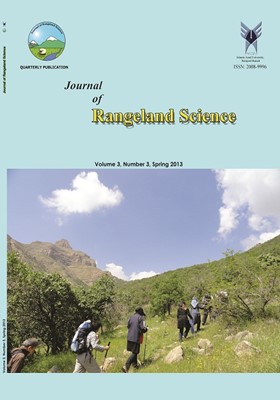Statistical Downscaling HadCM3 Model for Detection and Perdiction of Seasonal Climatic Variations (Case Study: Khabr Rangeland, Kerman, Iran)
محورهای موضوعی : Relationship between Animal and RangelandAmir Saadatfar 1 , Hossein Barani 2 , Abdol Reza Bahremand 3 , Ali Reza Massah Bavani 4 , Adel Sepehry 5 , Ahmad Abedi Servestani 6
1 - Dep. of Range Land Management, Agricultural Sciences & Natural Resources University of
Gorgan
2 - Dep. of Range Land Management, Agricultural Sciences & Natural Resources
University of Gorgan.
3 - Dep. of Watershed and Arid Zone Management, Agricultural Sciences & Natural
Resources University of Gorgan
4 - Irrigation Group, Abureyhan University, Tehran
5 - Dep. of Range Land Management, Agricultural Sciences & Natural Resources University of
Gorgan.
6 - Dep. of Agricultural Exyension and Education, Agricultural Sciences & Natural
Resources University of Gorgan.
کلید واژه: Climatic-Parameters, Hadcm3, LARS-WG, Khabr rangelands,
چکیده مقاله :
Rangelands are one of the most vulnerable parts concerning the climatechanges‟ impacts. These impacts are even stronger in the arid and semi-arid areas whererangeland ecosystems are in critical conditions. Therefore, it is crucial to figure out theactual dynamics of climate variations on the rangelands. The aim of this research was todetermine climate changes in Khabr rangeland, Kerman, Iran. So, four meteorological datasets of HadCM3 model including minimum and maximum temperature, precipitation andradiation rates were used to assess climate changes in the region. In this regard, climatechanges during 2011-2039 were assessed by downscaling HadCM3 data using LARS-WGmodel under three scenarios of B1, A2 and A1B. The results have showed that the rainfallrates of spring and summer would have declining trends under all three scenarios.Minimum and maximum temperature rates would increase in all seasons, and just radiationone showed a decreasing trend for winter. Based on A1B scenario, minimum andmaximum temperature rates had the highest increasing trend. Radiation and precipitationhad the highest increasing and declining trends in the A2 scenario, respectively. Moreover,the increase in maximum and minimum temperature rates was averagely greater than thepast and consequently despite the increasing trend in minimum and maximum temperaturerates, the increase in the mean temperature rate during this period would be expected.According to the results, Khabr rangeland‟s climatic conditions will be significantlydifferent in the next 30 years and long-term and strategic planning is necessary inconsistent with the management policies with these conditions.


